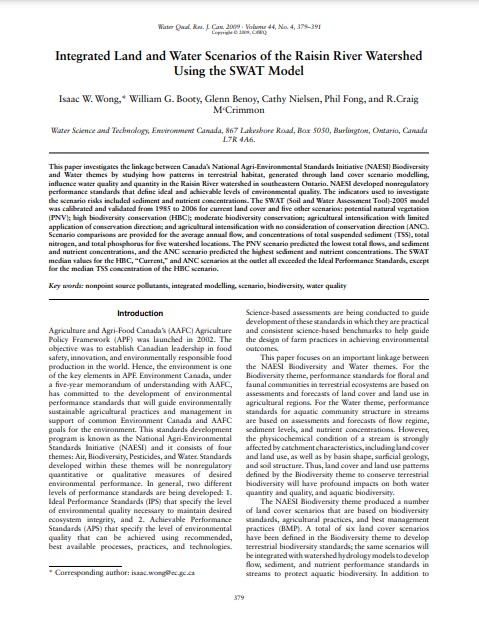Integrated land and water scenarios of the Raisin River watershed using the SWAT model.
Bosque Modelo:
Eastern Ontario
Temática:
Desarrollo humano
Tipo de documento:
Artículo científico
Resumen
This paper investigates the linkage between Canada’s National Agri Environmental Standards Initiative (NAESI) Biodiversity and Water themes by studying how patterns in terrestrial habitat, generated through land cover scenario modelling, influence water quality and quantity in the Raisin River watershed in southeastern Ontario. NAESI developed nonregulatory performance standards that defi ne ideal and achievable levels of environmental quality. The indicators used to investigate the scenario risks included sediment and nutrient concentrations. The SWAT (Soil and Water Assessment Tool)-2005 model was calibrated and validated from 1985 to 2006 for current land cover and five other scenarios: potential natural vegetation (PNV); high biodiversity conservation (HBC); moderate biodiversity conservation; agricultural intensifi cation with limited application of conservation direction; and agricultural intensification with no consideration of conservation direction (ANC). Scenario comparisons are provided for the average annual fl ow, and concentrations of total suspended sediment (TSS), total nitrogen, and total phosphorus for fi ve watershed locations. The PNV scenario predicted the lowest total fl ows, and sediment and nutrient concentrations, and the ANC scenario predicted the highest sediment and nutrient concentrations. The SWAT median values for the HBC, “Current,” and ANC scenarios at the outlet all exceeded the Ideal Performance Standards, except for the median TSS concentration of the HBC scenario.
Información Bibliográfica
Autor:
Wong, I. W., Booty, W. G., Benoy, G., Nielsen, C., Fong, P., & McCrimmon, R. C.
Revista:
Water Quality Research Journal
Año:
2009
N°:
4
País :
Canadá
Páginas:
379 - 391
Volumen:
44
Idioma:
Ingles
Palabras claves
nonpoint source pollutants, integrated modelling, scenario, biodiversity, water quality





